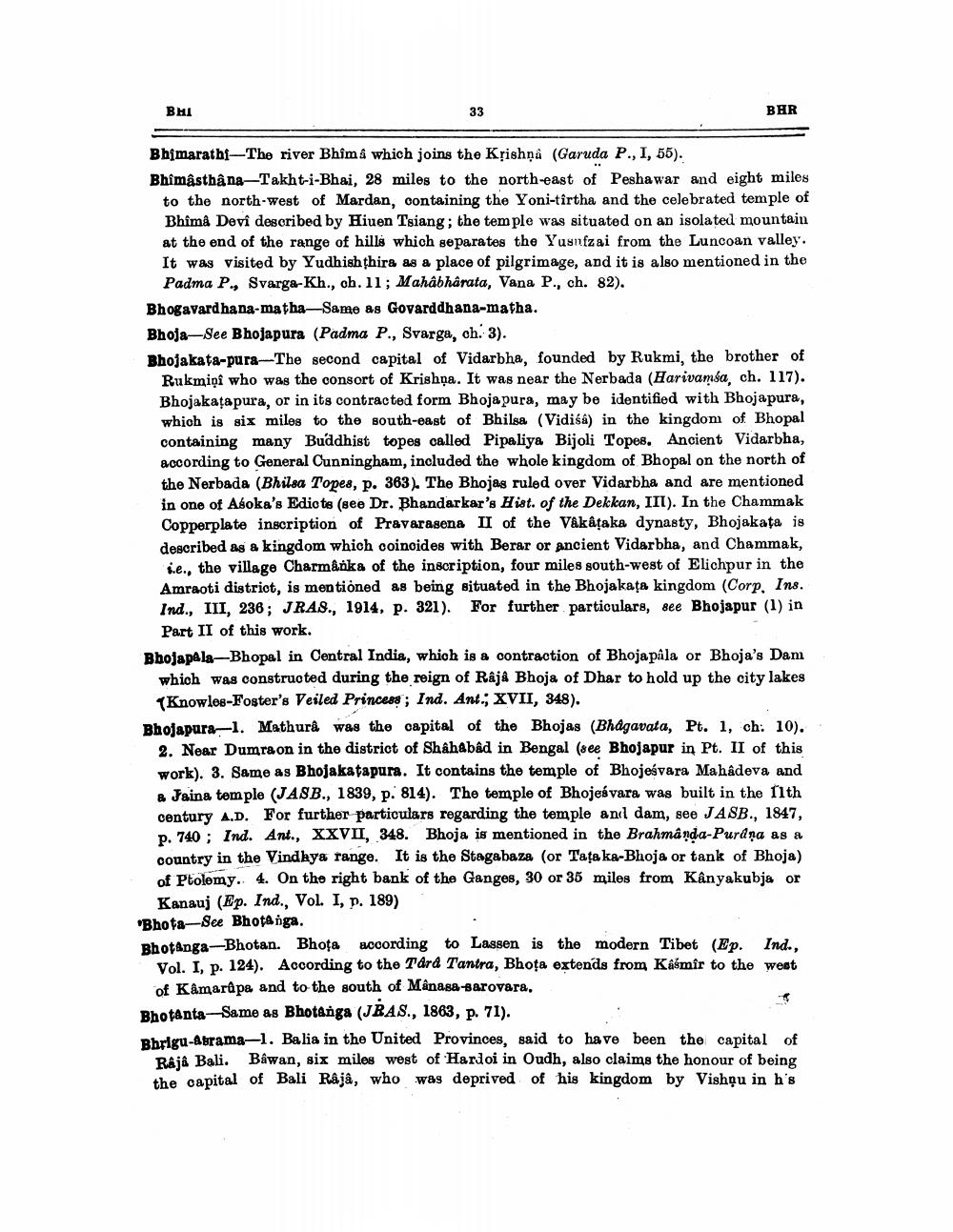________________
BHI
33
BHR
Bhimarathi-The river Bhima which joins the Krishna (Garuda P., 1, 55). Bhimasthậna-Takht-i-Bhai, 28 miles to the north-east of Peshawar and eight miles to the north-west of Mardan, containing the Yoni-tartha and the celebrated temple of Bhima Devi described by Hiuen Tsiang; the temple was situated on an isolated mountain at the end of the range of hills which separates the Yuenfzai from the Luncoan valley. It was visited by Yudhishthira as a place of pilgrimage, and it is also mentioned in the
Padma P., Svarga-Kh., ch. 11; Mahâbhârata, Vana P., ch. 82). Bhogavardhana-matha-Same as Govarddhana-matha. Bhoja–See Bhojapura (Padma P., Svarga, ch. 3). Bhojakata-pura-The second capital of Vidarbha, founded by Rukmi, the brother of
Rukmiņi who was the consort of Krishņa. It was near the Nerbada (Harivamsa, ch. 117). Bhojakațapura, or in its contracted form Bhojapura, may be identified with Bhojapura, which is six miles to the south-east of Bhilsa (Vidish) in the kingdom of Bhopal containing many Buddhist topes called Pipaliya Bijoli Topes. Ancient Vidarbha, according to General Cunningham, included the whole kingdom of Bhopal on the north of the Nerbada (Bhilsa Topes, p. 363). The Bhojas ruled over Vidarbha and are mentioned in one of Asoka's Ediots (see Dr. Bhandarkar's Hist. of the Dekkan, III). In the Chammak Copperplate inscription of Pravarasena II of the Vakațaka dynasty, Bhojakata is described as a kingdom which coincides with Berar or ancient Vidarbha, and Chammak,
se., the village Charmanka of the inscription, four miles south-west of Elichpur in the Amraoti district, is mentioned as being situated in the Bhojakata kingdom (Corp. Ins. Ind., III, 238; JRAS., 1914, p. 321). For further particulars, see Bhojapur (1) in
Part II of this work. Bhojapala-Bhopal in Central India, which is a contraction of Bhojapala or Bhoja's Dam which was constructed during the reign of Raja Bhoja of Dhar to hold up the city lakes
(Knowles-Foster's Veiled Princess; Ind. Ant., XVII, 348). Bhojapura-1. Mathura was the capital of the Bhojas (Bhagavata, Pt. 1, ch: 10).
2. Near Dumraon in the district of Shahabad in Bengal (see Bhojapur in Pt. II of this work). 3. Same as Bhojakatapura. It contains the temple of Bhojesvara Mahadeva and & Jaina temple (JA8B., 1839, p. 814). The temple of Bhojesvara was built in the 11th century A.D. For further particulars regarding the temple and dam, see JASB., 1847, p. 740 : Ind. Ant., XXVII, 348. Bhoja is mentioned in the Brahmânda-Purdņa as a country in the Vindhya range. It is the Stagabaza (or Tața ka-Bhoja or tank of Bhoja) of Ptolomy. 4. On the right bank of the Ganges, 30 or 35 miles from Kânyakubja or
Kanauj (Ep. Ind., Vol. I, p. 189) "Bhota-See Bhotanga. Bhotanga-Bhotan. Bhota woording to Lassen is the modern Tibet (Ep. Ind.,
Vol. I, p. 124). According to the Tara Tantra, Bhoța extends from Kasmir to the west
of Kamarapa and to the south of Managa-sarovara. Bhotanta-Same as Bhotanga (JRAS., 1863, p. 71). Bhrigu-Asrama-1. Balia in the United Provinces, said to have been the capital of
Raja Bali. Bawan, six miles west of Hardoi in Oudh, also claims the honour of being the capital of Bali Râjâ, who was deprived of his kingdom by Vishộu in h's




